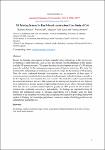3D printing system for earth-based construction: Case study of cob
| dc.contributor.author | Gomaa, M | |
| dc.contributor.author | Jabi, W | |
| dc.contributor.author | Veliz Reyes, Alejandro | |
| dc.contributor.author | Soebarto, V | |
| dc.date.accessioned | 2023-05-04T11:10:29Z | |
| dc.date.available | 2023-05-04T11:10:29Z | |
| dc.date.issued | 2021-04 | |
| dc.identifier.issn | 0926-5805 | |
| dc.identifier.other | 103577 | |
| dc.identifier.uri | https://pearl.plymouth.ac.uk/handle/10026.1/20785 | |
| dc.description.abstract |
Despite the dramatic development in digital manufacturing technologies in the recent years, 3D printing of earth materials, such as cob, still presents several challenges to the market-available 3D printing systems. This paper describes the development process of a 3D printing system for cob that fits the contemporary requirements of digital construction. The study first described the methodology of producing a revised cob recipe for the purpose of 3D printing. Then, the study conducted thorough investigations into the properties of three types of extrusion systems using both electromechanical and pneumatic methods, leading eventually to the development of a new bespoke dual-ram extruder. The study then explored systematically the relationship between the new 3DP system and the rheological properties of cob, followed by an exploration to the new geometric opportunities the new system offers. The study findings show that the new extrusion system improves greatly the 3DP process of cob in terms of extrusion rate, continuity, consistency, and mobility. The findings are expected to bring 3D printed cob construction closer to full-scale applications. On a broader scale the study contributes to the disciplines of architectural design and construction by providing a framework capable of bridging the knowledge gap between vernacular modes of building production and contemporary digital practice. | |
| dc.format.extent | 103577-103577 | |
| dc.language | en | |
| dc.publisher | Elsevier BV | |
| dc.title | 3D printing system for earth-based construction: Case study of cob | |
| dc.type | journal-article | |
| dc.type | Journal Article | |
| plymouth.volume | 124 | |
| plymouth.publication-status | Published | |
| plymouth.journal | Automation in Construction | |
| dc.identifier.doi | 10.1016/j.autcon.2021.103577 | |
| plymouth.organisational-group | |Plymouth | |
| plymouth.organisational-group | |Plymouth|Faculty of Arts, Humanities and Business | |
| plymouth.organisational-group | |Plymouth|Faculty of Arts, Humanities and Business|School of Art, Design and Architecture | |
| plymouth.organisational-group | |Plymouth|REF 2021 Researchers by UoA | |
| plymouth.organisational-group | |Plymouth|Users by role | |
| plymouth.organisational-group | |Plymouth|Users by role|Academics | |
| plymouth.organisational-group | |Plymouth|REF 2021 Researchers by UoA|UoA13 Architecture, Built Environment and Planning | |
| dcterms.dateAccepted | 2021-01-18 | |
| dc.date.updated | 2023-05-04T11:10:28Z | |
| dc.rights.embargodate | 2023-5-10 | |
| rioxxterms.versionofrecord | 10.1016/j.autcon.2021.103577 |


